Last Updated on January 6, 2024 by Greg Gillson
Did you see a brightly-colored red bird, orange bird, or yellow bird in Arizona and wonder what is was?
This page is for you!
This article shows you photos and identification of some of the most common birds in Arizona based on color.
The list of birds found in Arizona includes over 565 species. So, I can’t show you all of them. I’m going to assume that you saw a common bird of this color, but you certainly could have seen something less common, or even rare!
Shape (including the shape of the bill) and size are often more helpful in starting to identify a bird than the color. In fact, most birds in North American can be easily identified with a black-and-white photo!
Many birds are multi-colored, so that it may be hard to pick out a dominant color. Males and females may be colored quite differently. And some color patterns are similar among otherwise dissimilar species.
Nevertheless, I’m going to try to pick out some of the birds that you are most likely to see in backyards or towns. And I’ll show a few others that I get asked about a lot.
The birds with a noticeable amount of red on them in Arizona covered in this article are:
- House Finch
- Anna’s Hummingbird
- Northern Cardinal
- Vermilion Flycatcher
- American Robin
- Pyrrhuloxia
- Painted Redstart
- Broad-tailed Hummingbird
- Summer Tanager
The birds with a noticeable amount of orange on them in Arizona covered in this article are:
- Northern Flicker
- American Kestrel
- Spotted Towhee
- Black-headed Grosbeak
- Ruddy Duck
- Barn Swallow
- Cinnamon Teal
- Hooded Oriole
- Bullock’s Oriole
The birds with a noticeable amount of yellow on them, including lots of yellow and black birds, in Arizona covered in this article are:
- Lesser Goldfinch
- Verdin
- Yellow-rumped Warbler
- Yellow Warbler
- Cassin’s Kingbird
- Common Yellowthroat
- Western Kingbird
- Yellow-headed Blackbird
- Western Tanager
- Brown Crested Flycatcher
- Pine Siskin
- Wilson’s Warbler
- Yellow-breasted Chat
- Gilded Flicker
Red birds of Arizona
Birds get the red, orange, and yellow in their feathers from carotenoids in the fruit, seeds, and plants they eat (source).
These carotenoid colors combine with melanin to form an infinite range of red feathers–pink, rusty, scarlet, violet, red-orange.
The following are red birds that you are most likely to see in Arizona.
House Finch
When people ask about a bird with a red head at their feeder, it is usually this bird.
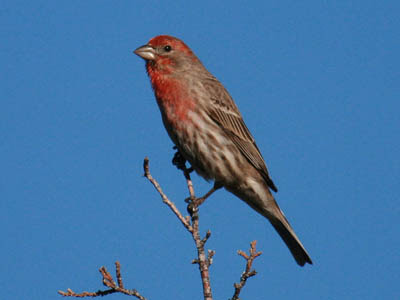 |
| Male House Finch. Greg Gillson. |
Males of this dusty brown striped finch have red limited to the head (specifically the forehead and eyebrow), breast (chest), and rump. The red coloration tends toward orangish, and may rarely be yellowish.
Females are streaked, similar to the males but without red. They lack any strong pattern on the face and head.
Note the small round head and curved upper ridge on the bill.
Some people call these red-headed sparrows. Sparrows and finches are similar, but in general, male finches are brighter than the females and tend to hang out more in trees. Sparrow genders are usually quite similar in coloration and tend to feed mostly on the ground.
These birds are common in residential areas, especially at bird feeders. In the West more widespread in arid regions near water.
House Finches are year-round residents throughout Arizona.
Anna’s Hummingbird
These are larger hummingbirds with red heads that don’t migrate.
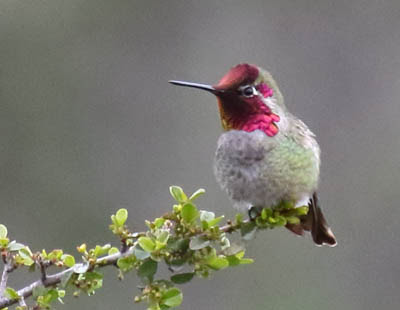 |
| Male Anna’s Hummingbird. Greg Gillson. |
These are big green hummingbirds. Adult males have the entire head red–forecrown and throat, actually. The color of the iridescent feathers is amethyst, a bright reddish purple color, tending towards pink.
Young males have just a spot of red on the center of the throat.
Females lack red, but often show a spot of iridescent green feathers on the center of the white throat. The upper breast is gray. The lower belly and flanks have a greenish tinge. Many other western hummingbird species have cinnamon color under the tail.
They are common in flower gardens and hummingbird feeders year-round.
Anna’s Hummingbirds are year-round residents in central and western Arizona, winter visitors only in southeastern Arizona.
Northern Cardinal
These are one of the most common backyard birds in the eastern United States. Their bright red color and unique head profile makes them instantly identifiable to most people–whether they are bird watchers or not!
 |
| Northern Cardinal. GeorgeB2 from Pixabay. |
Males of these large seed eaters are bright red with a black face and red crest.
Females replace most of the red with brown, The bill is large and orange.
These birds are found in woodlands, stream edges, residential areas.
Northern Cardinals are year-round residents in central and southeastern Arizona.
Vermilion Flycatcher
These small desert birds are a glowing hurt-your-eyes red!
 |
| Male Vermilion Flycatcher. Greg Gillson. |
Males are brilliant red on the crown and underparts. The back, wings, and tail are dark sooty brown.
Females and immature birds are paler. They are more grayish brown above, white below with streaked breast and belly that may be peachy yellow to orange-pink.
They are found in deserts near water, pastures, golf courses, ball fields.
Vermilion Flycatchers are year-round residents in southern and southeastern Arizona, summer residents only in central Arizona.
American Robin
These are familiar lawn birds with red breasts.
 |
| American Robin. Greg Gillson. |
Male American Robins are brownish-gray above with a brick red breast. Females are paler orange below and paler gray above.
They are widespread in open country with scattered deciduous trees, residential areas.
American Robins are year-round residents through most of Arizona, winter visitors only in southwestern Arizona.
Pyrrhuloxia
These gray and red desert birds are shaped like cardinals, to which they are related.
 |
| Pyrrhuloxia. Uploaded by berichard, CC BY 2.0, Link |
Males are pale gray with red highlights on face, crest, and chest.
Females are gray and buff-colored, with only a hint of red. The bill is yellowish and strongly curved on the culmen (upper ridge).
These birds are found in thorny desert scrub, such as mesquite, and also ranches.
Pyrrhuloxias are year-round residents in southeastern Arizona.
Painted Redstart
These are amazingly red-colored warblers of the Southwest.
 |
| Painted Redstart. Greg Gillson. |
These small birds are black above, including a hood. There is a large white wing patch. The breast and belly is deep red. They flash white outer tail feathers.
They are usually found near water in mountain pine-oak woodlands.
Painted Redstarts are summer residents in southeastern and central Arizona.
Broad-tailed Hummingbird
These hummingbirds of the mountain West have rosy-red throats.
 |
| Broad-tailed Hummingbird. Michelle Lynn Reynolds. CC BY-SA 3.0 |
Both genders are green above, white below, with green and buff flanks. Rusty bases to outer tail feathers.
Males have bright red throats.
Found in dry pine and montane forests.
Broad-tailed Hummingbirds are summer residents in northern and eastern Arizona.
Summer Tanager
These bright red birds are found toward the tops of tall trees in the southern United States.

Males are rose red with fairly heavy bill.
Females are yellowish or mustard-colored, some with a faint reddish wash.
In the East these birds are found in pine-oak woodlands. In the West they prefer tall cottonwood trees.
Summer Tanagers are summer residents in central, western, and southeastern Arizona, spring and fall migrants only in southwestern Arizona.
Orange birds of Arizona
True orange-colored birds are not that common. Many birds that I have here are paler rusty.
The common pattern is an orange body and black or brown wings and tail. Another common pattern is for the orange to be restricted to the under parts.
The following are orange birds that you are most likely to see in Arizona.
Northern Flicker
These unusual woodpeckers with orange under wings are just as likely to be found hopping on your lawn eating ants as they are to be calling from a dead tree top.
 |
| Northern Flicker. Greg Gillson. |
Where is the orange color?
Wait for it…
 |
| Northern Flicker. Greg Gillson. |
The shafts and undersides of the wing and tail feathers are a salmon orange color. A large white rump patch also attracts attention as these birds fly away.
Northern Flickers live in open woods, residential areas. Sometimes visit feeders in winter.
Northern Flickers are year-round residents through most of Arizona, winter visitors only in southwestern Arizona.
American Kestrel
These are the familiar small rusty-orange falcons sitting on power lines on the edge of the highway, or hunting and hovering over the median strip.
 |
| Female American Kestrel. Greg Gillson. |
Females are rusty orange barred with black on their back wings and tail. The under parts are buff with black spots. The head shows two facial stripes.
Males have blue-gray backs and rufous tail is unmarked except for black tail band.
These birds are found in open country, farms, pastures with perches.
American Kestrels are year-round residents throughout Arizona.
Spotted Towhee
These big sparrows with red sides superficially resemble the coloration of robins.
 |
| Spotted Towhee. Greg Gillson. |
These birds have dark hoods and upper parts with rusty rufous-red sides and white bellies. They have white spots over their wings, shoulders, and on their tail corners. The upper parts of the males are jet black, females dark brown. Some populations have paler orange sides.
These are somewhat shy birds that hide in the dense brush and spend most of their time on the ground. They visit feeders during quiet periods.
Spotted Towhees are year-round residents in northern, eastern and northeastern Arizona.
Black-headed Grosbeak
If you didn’t look closely at these big-billed birds, you might mistake these orange-breasted songsters for American Robins–their coloration and song are very similar!
 |
| Male Black-headed Grosbeak. Greg Gillson. |
Males have black and white wings and tail. Huge bill. The under parts are burnt orange, fading to yellow-orange mid-belly.
Females and first year birds have a striped heads and are brown above, pale buff or butterscotch-orange below.
These birds are found in deciduous or mixed woods. Visit bird feeders.
Black-headed Grosbeaks are summer residents in northern and eastern Arizona, spring and fall migrants only in west-central and southwestern Arizona.
Ruddy Duck
These small ducks are dark rusty-orange in spring.
 |
| Ruddy Duck. Greg Gillson. |
Males in breeding plumage (late winter and spring) are rusty, with a white face, and a blue bill. The long tail is often held sticking up. In winter they are brown, with white face, and dark bill.
Females all year are like winter males. Brown body, dark cap, dark line through eye of pale face. Dark bill.
These birds prefer weedy ponds to breed, but in winter may be found in deeper ponds in city parks.
Ruddy Ducks are year-round residents in the southern 2/3 of Arizona, winter visitors only in northern Arizona.
Barn Swallow
These orange-bellied birds are a familiar sight across North America in summer.
 |
| Barn Swallow. Greg Gillson. |
These birds are purple-blue above with orange under parts and long forked tails. The color of the underparts in winter or on females are often cinnamon or buff-colored, but breeding males can be brighter orange-red.
These birds swoop low over fields and wetlands at lower elevations. They may build their mud nests in rafters on porches, garages, or other out-buildings.
Barn Swallows are summer residents in central and southeastern Arizona, spring and fall migrants in northern, western, and southwestern Arizona.
Cinnamon Teal
What an unusually colored brownish-orange duck!
 |
| Male Cinnamon Teal. Greg Gillson. |
Males are dark cinnamon orange. The wing patches are blue, green, and white. The eye is red.
Females are more mottled brown with matching wing patches.
These birds are found in ponds and grass-lined ditches.
Cinnamon Teals are summer residents in northern and northeastern Arizona, year-round residents in a small area of central Arizona, winter visitors only in southern Arizona, and spring and fall migrants only in western Arizona.
Hooded Oriole
In the United States no other bird is so closely associated with palm trees as this bright orange oriole.
 |
| Male Hooded Oriole. Greg Gillson. |
Males of the western population are yellow-orange. Texas populations are more orange. The whole head is orange except for the black face and throat. The tail is solidly black, as seen in flight.
Females are yellow-green above and quite yellow below.
These birds are found in residential areas, parks, closely tied to Washingtonia palms.
Hooded Orioles are summer residents in southern, central, and southwestern Arizona.
Bullock’s Oriole
These bright orange and black birds are often seen in tall trees.
 |
| Male Bullock’s Oriole. Greg Gillson. |
The males of this species are very bright orange. The back and top of the heads are black. The black wings have large white wing patches. The tail is black with orange sides. The face is orange with a black line through the eye and a black throat.
Females and young are gray with yellow head and breast and tail.
These birds are more common in drier inland regions along watercourses in tall cottonwoods or shade trees. Rarely come to feeders for fruit or nectar in spring.
Bullock’s Orioles are summer residents in much of Arizona, spring and fall migrants only in southwestern Arizona.
Yellow birds of Arizona
Yellow is a common bird color! Often it is mixed with black and white plumage in birds.
Many birds with darker upper parts have yellow breast or belly.
The following are yellow birds you are most likely to see in Arizona.
Lesser Goldfinch
Lesser Goldfinches maintain their bright yellow plumage all year–even in the winter when American Goldfinches are rather brown and colorless.
 |
| Male Lesser Goldfinch. Greg Gillson. |
These tiny birds are bright yellow below (including under the tail), and green or black on the back. The wings and tail are black and white. Males have a black cap, which the females lack.
These birds are found near water in arid regions of the West and Southwest. They are common in residential areas, too, and come to bird feeders.
Lesser Goldfinches are year-round residents through much of Arizona, summer residents only in northeastern Arizona.
Verdin
These are like desert chickadees, but with yellow heads!
 |
| Verdin. Greg Gillson. |
Gray throughout. Adults have yellow head.
Found in thorny desert shrubs, residential areas.
Verdins are year-round residents in western, southern, and central Arizona.
Yellow-rumped Warbler
These are abundant warblers across North America. Affectionately called “butter butts” by many birders, because of their bright yellow rumps that flash in flight.
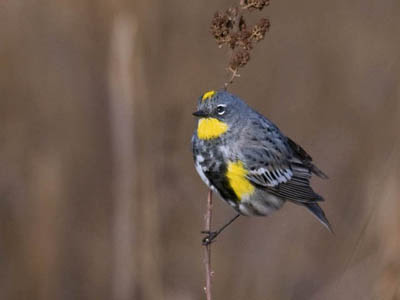 |
| Male Audubon’s Yellow-rumped Warbler. Greg Gillson. |
Western form (Audubon’s) with bright yellow throat and yellow rump. Large white wing patch.
Northern and Eastern form (Myrtle) with white throat, yellow rump, and two white wing bars.
Winter birds are dull gray brown, with bright yellow rump. Throat may be cream colored or white. Often difficult to tell the two forms apart in winter.
 |
| Winter Yellow-rumped Warbler. Greg Gillson. |
Breed in mountain or boreal conifers. Widespread in migration. Winter in low river bottoms, open weedy deciduous areas. Rarely come to feeders in winter.
Yellow-rumped Warblers are winter visitors throughout Arizona, they breed in high mountains from southeastern Arizona toward central Arizona.
Yellow Warbler
The golden yellow sun packed all into one little bird! Appears to be an all-yellow bird.
 |
| Yellow Warbler. Greg Gillson. |
Some populations are bright yellow, some tend toward greenish on upper parts, some more golden. Yellow internal tail corners in flight.
Males with red breast streaking, again, variable by population.
Females somewhat to much paler yellow, some greenish, some whitish. Lack red streaks.
These birds are found in willow thickets on the edge of wetlands and ditches, stream sides in arid regions.
Yellow Warblers are summer residents in south-central and southeastern Arizona, rare summer residents across northern Arizona, spring and fall migrants throughout Arizona.
Cassin’s Kingbird
These noisy yellow-bellied flycatchers of the Southwest are similar to the more widespread Western Kingbirds.
 |
| Cassin’s Kingbird. Greg Gillson. |
These large-headed birds sit upright. The head is dark gray with sharply-defined white throat. The belly is yellow. The dark brown tail has an indistinct pale tip.
These birds inhabit a wide variety of habitats. They usually include tall trees and open spaces in their home ranges. Open woods, canyons, and parks all suit these birds.
Cassin’s Kingbirds are summer residents in northern, eastern, and southeastern Arizona.
Common Yellowthroat
These buttery yellow birds are abundant in the marsh vegetation.
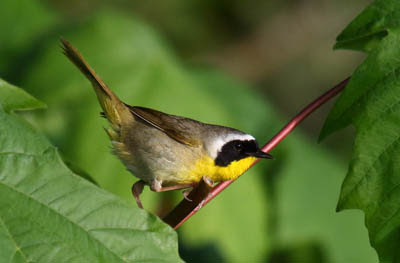 |
| Male Common Yellowthroat. Greg Gillson. |
These skulkers have bright yellow throats and yellow undertail coverts. Males have a black domino mask edged broadly in white, which females lack. Upperparts are dull olive-green.
Immature males in fall show a shadowed black mask.
Found in damp situations and heavy deciduous brambles following clear cuts.
Common Yellowthroats are summer residents throughout Arizona, they are year-round residents in western Arizona along the Colorado River, and at a few places in southeastern Arizona.
Western Kingbird
These yellow-bellied birds of the prairies often perch on power lines and fence lines.
 |
| Western Kingbird. Greg Gillson. |
These birds are pale gray on the head and breast. Brown wings. The belly is lemon yellow. Black tail has white outer tail feathers, especially obvious in flight.
These are birds of prairies, deserts, pastures, often near water.
Western Kingbirds are summer residents throughout Arizona.
Yellow-headed Blackbird
These blackbirds with yellow heads are found in marshes in the West.
 |
| Yellow-headed Blackbird. Greg Gillson. |
Males are glossy black with bright golden-yellow head and breast. White wing patches.
Females are duller brown with mottled yellow breast.
These birds nest in cattail marshes in prairies. Winter in large flocks in agricultural areas.
Yellow-headed Blackbirds are summer residents in east-central Arizona, year-round residents along the Colorado River in western Arizona, winter visitors in southeast Arizona, and spring and fall migrants throughout.
Western Tanager
Numbers of these bright black and yellow birds may show up overnight in backyards in spring migration. Then they disappear the next night.
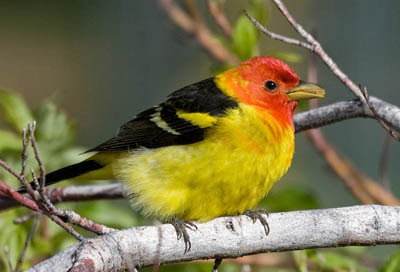 |
| Western Tanager. Greg Gillson. |
Males are brilliant golden yellow with black back, wings, and tail, and a red or orange face. Swollen yellow bill.
Females are more green or gray, with darker wings and tail. Lack red face.
They are found in a variety of wooded habitats, usually conifers or mixed conifer woods, and residential areas with large trees, including mature conifers. Usually don’t visit feeders.
Western Tanagers are summer residents in northern and northeastern Arizona, spring and fall migrants throughout.
Brown Crested Flycatcher
These flycatchers with yellow belly and rusty flight feathers are found in the desert.
 |
| Brown-crested Flycatcher. Greg Gillson. |
These birds are brown above, gray on the upper breast, with yellow belly. The under tail and edges of wing feathers are rusty-orange.
They live in sycamores and desert stream edges.
Brown-crested Flycatchers are summer residents across the southern half of Arizona.
Pine Siskin
These small brown-streaked birds are relatives of the goldfinches. But you would never know it until they fly and sport yellow wing stripes and tail base. Usually in flocks.
 |
| Pine Siskin. Greg Gillson. |
These birds are streaked brown. In flight they have a yellow stripe down the length of the wing. The sides of the base of the tail is also yellow. Some birds are paler, some darker, others brighter yellow, others duller.
These birds are found in summer in northern conifer woods. Irregularly irrupt hundreds of miles southward. Frequent at feeders.
Pine Siskins are year-round residents in mountains through most of Arizona, winter visitors only in southwestern Arizona.
Wilson’s Warbler
These bright yellow birds are very common, both on their summer territories and in migration.
 |
| Male Wilson’s Warbler. Greg Gillson. |
These birds are bright yellow in the West, more greenish above in the East. Only males have the black cap.
Both genders have a beady black eye in the middle of the yellow face.
These birds live in damp understory, tangles, willows.
Wilson’s Warblers are common spring and fall migrants throughout Arizona.
Yellow-breasted Chat
These unique larger yellow birds may sing day and night, and include whistles and crow-like cawing, often given in a display flight.
 |
| Yellow-breasted Chat. Greg Gillson. |
These birds are greenish above with bright yellow breast and white belly. They have a dark mask bordered with white.
These birds live in tangles and wet streamside woods.
Yellow-breasted Chats are summer residents throughout Arizona in appropriate habitat.
Gilded Flicker
These woodpeckers, very similar to Northern Flickers, are yellow under the wings and tail. They are restricted to the desert Southwest.

These larger woodpeckers are brown on the back with thin black bars. The under parts are pinkish with round black spots. There is a black crescent across the chest. The face is gray with a brown crown. The undersides of the wing and tail feathers are bright yellow, best seen in flight.
Males have a red whisker, which is lacking in females.
These are birds of the Sonoran Desert, found especially on the large saguaro cacti.
Gilded Flickers are year-round residents in the southwestern half of Arizona.
Wrapping Up
Here are some additional interesting facts about red, yellow, and orange feathers:
- Some birds use a combination of pigments and feather structure to achieve their vibrant colors. For example, the iridescent green throat of an Anna’s hummingbird appears green due to the interaction of light with microscopic structures on the feathers, not just pigment.
- Some birds can control the brightness of their plumage. For example, the Northern Cardinal can slightly puff out its feathers, making the red appear more intense during courtship displays.
- Bird coloration can change with age and diet. Some young birds develop their full vibrant colors only after reaching adult plumage, and changes in food availability can affect the intensity of their hues.
Bird coloration is a complex story woven from pigments, genetics, and ecology. Understanding these factors leads to a deeper appreciation for the stunning plumage that adorns our feathered friends and the fascinating evolutionary forces that shaped their vibrant hues.
So, the next time you admire a fiery cardinal or a dazzling tanager, remember that their colors are not just beautiful decorations, but intricate stories of their diet, genes, and life in the great avian orchestra of nature.
Frequently Asked Questions
What is the brightest red bird of Arizona?
Determining the “brightest red” bird in Arizona is a bit subjective, as perception of brightness depends on lighting, viewing angle, and individual preferences. But, you cannot really go past the Vermilion Flycatcher. This fiery little gem might be small, but its coat of vermilion red truly pops against the arid backdrop. They perch prominently on cacti and shrubs, making their color difficult to miss.
What is the brightest yellow bird of Arizona?
Crowning the “brightest yellow bird” in Arizona isn’t a straightforward task, as brightness is subjective and depends on factors like lighting and individual variations. However, my pick is the Wilson’s Warbler. This tiny songbird boasts a stunning lemon-yellow breast and olive green back, a combination that shines brilliantly in sunlight. Look for them flitting through trees and shrubs in open woodlands and riparian areas during spring and summer.
What is the brightest orange bird of Arizona?
There are several contenders that stand out with their fiery plumage that illuminates the arid landscapes. But a clear winner is the male Hooded Oriole features a bright orange body with black highlights, adding a splash of citrus to desert habitats.
________________________________________________________________________________________________
Related articles:
See photos and learn about the most common backyard birds in Arizona, regardless of color.
See photos and learn what to feed winter birds in Arizona.
Here’s a quick tutorial of how I would teach you to identify birds: 7 Steps to Identify Birds!
Birds with red heads in North America.
Yellow-and-black birds in North America.











Thank you SO MUCH! My recent retirement has allowed me to hike and begin to notice the beautiful birds I share my neighborhood with, Phoenix Mountain Preserve. I look forward to learning more about them.
You are so welcome! I'm spending this winter in Ajo. Mostly desert birds, but so enjoyable.
Thanks for the info I appreciate it
I looked here to see if I could identify the bird I saw sitting on my desert marigold plant here in Maricopa county.
Tiny, yellow chest, dark wings, not a hummingbird.
In your area, Verdin is the most likely, then Lesser Goldfinch. Both are in this article.
I'm in Williamson Valley and saw a flock of birds that were medium, not small like finch. They were a deep brown on the outer and bright yellow under. They flew low over my deck so I could see them well. Have never seen birds like that.
Your description matches meadowlarks. There are Western and Eastern Meadowlarks in Arizona.
They are bigger than finches, brown above, yellow below, and are often found in flocks.
Thank you for your beautiful clear pictures. I was able to identify a Male Hooded Oriole in my back yard. First time ever!!!
Wow, I just looked it up and my very first sighting of Hooded Oriole was in March 1978 in Bellflower, Los Angeles Co.
Thanks Greg. I really enjoyed this article!
Glad you enjoyed it, Linda.
Thank you for this great information! I have seen a beautiful male Vermillion Flycatcher 3x in the past week! Once, a pair of males, so pretty!
They are wonderful, aren't they? Thanks for your sighting!